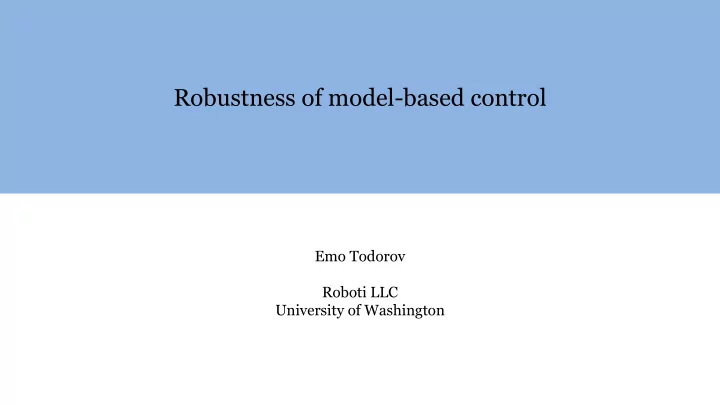

Robustness of model-based control Emo Todorov Roboti LLC University of Washington
Model-based control already works on complex dynamical systems Abbeel et al, IJRR 2010 nominal model physics model predictive control Williams et al, ICRA 2016 adaptive Kumar et al, ICRA 2016 local model offline trajectory optimization Mordatch et al, IROS 2015 randomized physics model policy OpenAI, 2018 gradient + quadrupeds
Model- free RL sounds great, but … Existing results are impressive mostly because of computer vision. Works well in quasi-static tasks where sampling is safe/automated and suboptimal solutions are feasible. Mechanical contraptions enable safe/automated sampling, but they limit real- world applications … … unless reality = publishing ☺ There are situations where control is easier than modeling, but that alone does not make model-free RL a good idea. Alternative to learning/optimization: design a controller manually, then tune a small number of control parameters on the real system. Expert manual design + parameter tuning can still outperform any form of learning.
Models can do more than sample data physics model physics model system identification data: (s, a, s’, r) data control action synthesis end-effector Jacobians dynamics derivatives inverse dynamics actuation subspaces machine control distance functions learning synthesis stability criteria
MuJoCo (2009-2019) ~ 10,000 active licenses Forward dynamics: numerical solution (convex optimization) Inverse dynamics: analytical solution Now has analytical derivatives! 10-core processor
Optico (2016-2019) Unified environment for physics modeling, cost function specification and model-based optimization: control, estimation, system id, mechanism design Speed goals: ensemble MPC in real-time (on desktop) long trajectory optimization in seconds model/policy/value parameter learning in minutes CONSOLE GUI CLIENT CLIENT SERVER WORKSPACE SDK
Deterministic dynamics and initial states Training policies with diverse initial states avoids overfitting and increases robustness. MDP/RL : stochastic Control : deterministic In a deterministic system moving towards some goal, the initial state determines what other states are visited. Different initial states may require different control strategies. Rajeswaran et al, NIPS 2017
Physically-consistent state estimation and system identification given noisy sensor data: estimate jointly : - movement kinematics - kinematics - contact forces - forces - actuator forces - model parameters contacts introduce strong coupling between state estimation and system identification: trajectories arrowhead Hessian model parameters linear policy 2 min NPG training on 24 CPU cores Kolev and Todorov, Humanoids 2015 Lowrey et al, SIMPAR 2018
Learning to act like a model If we cannot make the model behave like the robot, make the robot behave like the model. let the true (but hard to model) dynamics be x’ = f(x, u) specify reference model x’ = r(x, v) where v is some abstract control learn feedback transformation u = g(x, v) such that f(x, g(x, v)) = r(x, v) do model-based control with respect to r(x, v) Examples: high-gain PID control (r : identity), feedback linearization (r : linear). Specific motivation: we built an amazing robot that we never controlled properly, even though it has very fast and strong actuation.
Sim-to-real transfer Collect real data and do the best system identification possible. Build a model-based controller (and a state estimator). Test on the real system as early as possible . In many cases it will just work. If it fails, options are: make controller less aggressive (gain reduction, larger control cost, smoothness) ensemble optimization / domain randomization / diverse initial states / min-max adaptive control: extend system id with data collected while running controller augment physics-based model with non-parametric models trained on residuals learn feedback transformation making the real system behave like the reference model There are multiple good options for sim-to-real transfer, and they are relatively easy to try. Building the model-based controller (and estimator) in the first place is the more difficult part.
Recommend
More recommend